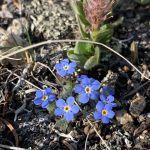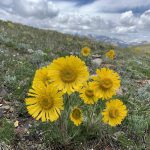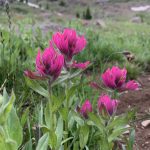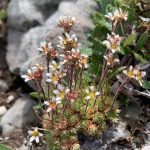History of the Colorado Alpine Ecoflora Project
Here at Betty Ford Alpine Gardens, the North American Botanic Garden Strategy for Alpine Plant Conservation (the Alpine Strategy, for short) guides our conservation efforts. The Alpine Strategy is a blueprint for the conservation and protection of alpine plants and their habitats in the US, Canada, and Mexico, with a focus on the role of botanic gardens in this effort. It was developed by Executive Director, Nicola Ripley, and published in 2020 in conjunction with Denver Botanic Gardens. There are four main objectives: understanding and documenting alpine plant diversity, conserving alpine plants and their habitats, promoting awareness of the alpine ecosystem through education and outreach, and building capacity for alpine plant conservation.
As part of the first objective, we have developed a map of the alpine areas in North America using Geographic Information Systems (GIS), a suite of powerful tools to understand and visually render detailed geographic data. We have also recently completed a years-long effort to compile a list of all North American alpine plant taxa, their distributions, and conservation statuses using field guides, online resources, and personal observations. We want to know what we are conserving, as well as where to find it! Traditionally, scientists use surveys and specimen collection to create what is referred to as a Flora, or a document of all the plants in an area (such Dr. Jennifer Ackerfield’s Flora of Colorado, the gold standard our team uses for plant identification). However, this is generally not a dynamic understanding of where these plants are or their phenology throughout the season, and is limited by when and where scientists go. When members of our team go out into alpine environments, they make a floristic inventory, essentially a list of all the plants they see and their phenology. But we are only a few individuals and the alpine plant season is very short, so we wanted to find a way to see what alpine plants are where, beyond what we could observe ourselves. This led to the creation of the Colorado Alpine EcoFlora Project.
As of October 2022, there are almost fifteen thousand(!!!) observations of more than seven hundred species in the Colorado Alpine EcoFlora Project. Many of these are already research-grade, having been verified by other users! Over the next several years, we plan to expand participation in the Colorado Alpine EcoFlora Project by reaching out to other interested organizations; planning BioBlitzes as training events where we can educate people on how to use iNaturalist, how to identify alpine plants, and canvas an area as group to document plant diversity; and EcoQuests, essentially scavenger hunts for plants, a program that has been successful at other gardens for getting information about a particular species or area.







